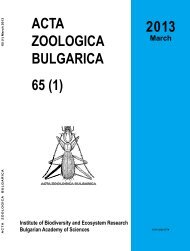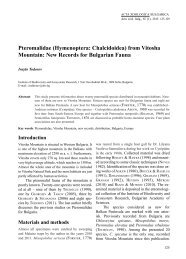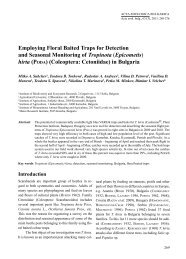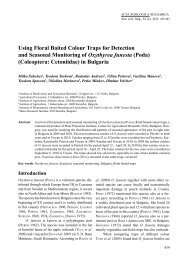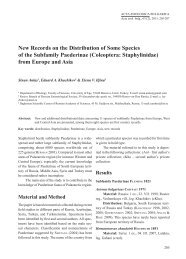supplement-4-205-214.. - Acta zoologica bulgarica
supplement-4-205-214.. - Acta zoologica bulgarica
supplement-4-205-214.. - Acta zoologica bulgarica
You also want an ePaper? Increase the reach of your titles
YUMPU automatically turns print PDFs into web optimized ePapers that Google loves.
Introduction<br />
Interruption of the river longitudinal connectivity<br />
through construction of barriers, such as hydroelectric<br />
power plants, dams, weirs, culverts, and bridges,<br />
is one of the most serious and widespread modifications<br />
of running water ecosystems (Wa r d, Sta n f o r d<br />
1979, dy n e S i u S, nilSSon 1994, We l c o m m e 1994,<br />
Ju n g W i rt h 1998, nilSSon et al. 2005). In many cases<br />
river fragmentation leads to significant habitat degradation<br />
as a result of changes in different physical<br />
and chemical parameters, such as water velocity,<br />
temperature regime, sedimentation processes, nutrition<br />
accumulation (Ki n g S f o r d 2000). Obstructions<br />
restrict the free-flowing rivers and suppress drift de-<br />
ACTA ZOOLOGICA BULGARICA<br />
<strong>Acta</strong> zool. bulg., Suppl. 4, 2012: <strong>205</strong>-214<br />
Effect of River Fragmentation on the Abundance and Size<br />
Structure of Barbus petenyi (Actinopterygii: Cyprinidae),<br />
Iskar River, Bulgaria<br />
Eliza Uzunova 1 , Anna Futekova 1 , Ivelina Milanova 2 , Lidia Rashkova 3<br />
1 Department of General and Applied Hydrobiology, Faculty of Biology, Sofia University, 8 Dragan Tsankov Blvd., Sofia 1164,<br />
Bulgaria; E-mail: e_uzunova@abv.bg<br />
2 Executive Environment Agency, 136 Tsar Boris III Blvd., Sofia, Bulgaria<br />
3 National Agency for Fisheries and Aquaculture, 17. Hristo Botev Blvd., Sofia, Bulgaria<br />
Abstract: Habitat fragmentation affects the populations of many fish species, but little attention is paid to cyprinids.<br />
The black barbel, Barbus petenyi (he c K e l 1852) is a characteristic species in the mountain and submountain<br />
streams of the lower Danube tributaries. B. petenyi is of particular interest because of its value<br />
as a game fish and as well as an indicator species listed in Annex II of the European Commission’s<br />
Habitats and Species Directive (92/43/EEC). The 19 km sector of the upper section of Iskar River<br />
was investigated during May-June, 2011. In the investigated zone, five flow-obstructing structures (weirs)<br />
were identified that have the potential to prevent or limit the upstream movement of B. petenyi. The<br />
abundance (ind.∙100 m -2 ), biomass (kg∙100 m -2 ) and size structure of B. petenyi were determined immediately<br />
downstream and upstream of each weir. It was observed that the abundance of B. petenyi declined<br />
dramatically in upstream direction due to the restricted re-colonization and migration processes. Barbel<br />
abundance did not depend on the distances between fragmentation structures. A significant difference was<br />
found in the body length frequencies of the barbel caught above the weir compared to those caught below.<br />
Several protection measures are discussed.<br />
Key words: river fragmentation, Barbus petenyi, fragmentation, abundance, size structure, Iskar River<br />
tritus and invertebrates, i.e. physical barriers reduce<br />
the biological productivity of the ecosystem (co rt e S<br />
et al. 2002). Particularly more sensitive to the effects<br />
of fragmentation are fishes performing significant<br />
migrations (Ju n g W i rt h 1998, no rt h c o t e 1984,<br />
no rt h c o t e 1998).It is considered that the adverse<br />
impact of physical barriers on fish is due not only to<br />
the disturbance in the seasonal breeding and migration,<br />
but also to limited access to preferred habitat<br />
and food resources, increasing the chances of occurrence<br />
of disease, reducing the gene flow between<br />
individuals constituting the population (Ph i l i P Pa rt<br />
et al. 1988, aa rt S et al. 2003, lu c a S, Ba r a S 2001,<br />
<strong>205</strong>
Uzunova E., A. Futekova, I. Milanova, L. Rashkova<br />
Bl a n c h e t et al. 2010). The river impoundment are<br />
associated with significant changes in fish community<br />
structure, age-size structure of native species<br />
and dispersal of non-native fish species (tay l o r et<br />
al. 2001, mi r a n d a et al. 2005, ha B i t et al. 2007,<br />
al e x a n d r e, al m e i d a 2010). For many years the attention<br />
was focused mainly on salmonid species and<br />
it was considered that the other fish species were less<br />
threatened in case of river fragmentation (Wa r d 1927,<br />
Jo h n S o n 1960, mo r i ta, ya m a m o t o 2002). In the last<br />
few years this opinion changed mainly because of<br />
awareness that non-salmonid fishes also migrate in<br />
rivers, seeking shelter or food, and of the possibility<br />
that the upstream obstructions may be linked to<br />
the declining resident fish communities (co W x 1998,<br />
Pe t e r 1998). It is now known that many rheophilic<br />
cyprinids from the temperate zones perform short<br />
and medium distance migrations (mo n t g o m e ry et<br />
al. 1983, Wh e l a n 1983, no rt h c o t e 1984, l’aB é elu<br />
n d, Vø l l e S ta d 1987, ty u S 1985, Sm i t h 1991,<br />
lu c a S, Ba r a S 2001). An example of such a species<br />
is Romanian barbel, Barbus petenyi (Heckel<br />
1852, Teleostei, Cyprinidae) known in Bulgaria as<br />
black or stream barbel. B. petenyi belongs to genus<br />
Barbus, family Cyprinidae (tS i g e n o P o u l o S et al.<br />
1999; tS i g e n o P o u l o S, Be r r e B i 2000), and is one of<br />
the four barbel species described in Bulgarian fresh<br />
waters (Be r r e B i et al. 1996, Ko t l i K, Be r r e B i 2002,<br />
Ko t t e l at, fry h o f 2007). B. petenyi is widely distributed<br />
in the mountain and sub-mountain reaches of<br />
rivers flowing into the Danube River (dr e n S K i 1921,<br />
dr e n S K i 1951, Pa S Pa l e V, Pe S h e V 1955, Ka r a P e t K o Va<br />
1994, he c K e l, Kn e r 1858, di K o V et al. 1988, di K o V<br />
et al. 1994, Ko t l i K, Be r r e B i 2002, tr i c h K o Va et al.<br />
2004). Representatives of the genus Barbus have<br />
been found to perform migration for foraging, shelter<br />
and spawning. For example, male and female B.<br />
barbus and B. meridionalis migrate during the spring<br />
to spawning grounds (Ba r a S, ch e r ry 1990, Ba r a S<br />
1992, lu c a S, Bat l e y 1996, lu c a S, fr e a r 1997,<br />
Vi l i z z i et al. 2006). Movements from several meters<br />
to 20 km in length have been reported (Ba r a S 1992,<br />
Lu c a s, Fr e a r 1997, Pe ň á z et al. 2002). In larger<br />
rivers such as Rhine and Danube, some of barbels<br />
tagged by St e i n m a n n et al. (1937) were re-captured<br />
in a distance more than 300 km from their release<br />
site. It is considered that the main purpose of these<br />
movements is searching suitable spawning ground.<br />
Another part of the local migrations are performed<br />
by juvenile fish which are strong enough to return<br />
206<br />
back in the upper reaches, where their feeding and<br />
breeding locations are. Sometimes in slow-current<br />
stretches of rivers some small immature individuals<br />
may be seen and it might be wrongly interpreted that<br />
there is suitable habitat for the species in standing<br />
water bodies. In fact, however, these fish have been<br />
transported downstream by the strong water flow<br />
usually during spring mounts.<br />
As the black barbel is a rheophilous species, it<br />
is sensitive to the changes in the structural diversity<br />
of rivers and some local populations may be in risk<br />
of extinction as a result of river regulation (St e fa n o V<br />
2007, PaV l o Va , Pe h l i Va n o V 2009). Therefore, the<br />
black barbel could be used as a functional describer<br />
or ‘indicator species’. B. petenyi is listed in Annex II<br />
of the European Commission’s Council Directive<br />
92/43/EEC. The black barbel’s habitats fall within<br />
40 of the proposed 225 sites from the European ecological<br />
network NATURA 2000 in Bulgaria.<br />
A key question when it comes to building water<br />
abstraction weirs or hydroelectric power plants<br />
is whether river modification is a potential limiting<br />
factor for the distribution of the black barbel and<br />
whether its populations in such regulated river in<br />
Bulgaria are at real risk. Adequate assessment of the<br />
actual status of the fish population should include<br />
the following criteria: fish abundance (density), sizeage<br />
structure and distribution of the target species in<br />
individual rivers (co W x et al. 2009).<br />
The aim of this study was to assess the possible<br />
influence of river fragmentation by weirs on<br />
the basic population parameters of B. petenyi inhabiting<br />
the upper zone of the River Iskar. To this<br />
end, our specific objectives were: 1) to determine<br />
the abundance and biomass of the black barbel<br />
upstream and downstream of the river obstructing<br />
devices; 2) to determine the size structure of the<br />
barbel inhabiting areas upstream and downstream<br />
of each fragmentation. This information will contribute<br />
to future plans for management of this species<br />
and help assess the need for implementation of<br />
conservation measures.<br />
Material and Methods<br />
Study area<br />
The study was conducted in the upper course of Iskar<br />
River, Bulgaria, during May-June, 2011. It is the<br />
longest Bulgarian river (about 360 km), with many
Effect of River Fragmentation on the Abundance and Size Structure of Barbus petenyi...<br />
reservoirs built on it. It is formed by the confluence<br />
of Cherni Iskar, Levi Iskar and Beli Iskar Rivers. The<br />
average slope of the catchment is 6.7‰ (a maximum<br />
value of 233‰ and a minimum of 0.75‰). The average<br />
rate of discharge in the main river for the period<br />
2003–2004 was 4.55 L/s/km 2 (DRBD, 2004). In<br />
the upper reaches (Rila Mountains), the rate of discharge<br />
has the highest value (36.4 L/s/km 2 , Cherni<br />
Iskar River), which gradually decreases downstream<br />
until it reaches Sofia Plain. In the Balkan Range, the<br />
rate of discharge again increases to 7.47 L/s/km 2 , and<br />
after the confluence with Zlatna Panega River, its<br />
value decreases to 6.52 L/s/km 2 . In the upper stream<br />
of Iskar River there are four reservoirs: ‘Beli Iskar’,<br />
‘Iskar’, ‘Pasarel’ and ‘Pancharevo’.<br />
The study area was located along the upper<br />
Iskar River within a range of 20 km and at altitudes<br />
of 940-1020 m a.s.l. (Fig.1). In this zone, five flowobstructing<br />
structures (weirs) with mean height of<br />
3 m and two reservoirs (‘Iskar’ and ‘Pasarel’) were<br />
identified that have the potential to prevent or limit<br />
the upstream movement of fish species. For the purposes<br />
of this study we selected 12 sampling sites.<br />
The sites are grouped into three categories: directly<br />
downstream of the weirs (DW), directly uppstream<br />
of the weirs (UW), one site between ‘Pasarel’ and<br />
‘Iskar’ reservoirs (P1) and one site at least 3 km<br />
away from the last upstream weir (S12). All investigated<br />
sites represent adequate river morphology<br />
and are characterized by alternating poo-–riffle<br />
sequences. The length of each study site is within<br />
10-40 river widths (co W x et al. 2009). The black<br />
barbel co-existing species were: Squalius cephalus,<br />
Alburnoides bipunctatus, Gobio gobio, Phoxinus<br />
phoxinus, Romanogobio kessleri, Romanogobio<br />
uranoscopus and Sabanejewia balcanica.<br />
Fish Sampling<br />
Fish were collected in the period after peak of high<br />
water (May-June 2011) by electrical fishing (model<br />
Samus-725G) (DC, 30 cm diameter aluminium anode,<br />
medium voltage from 200 V to 350 V, current<br />
strength average of 3 A to 8 A, depending on water<br />
electroconductivity) and frequency of 45 pulses per<br />
second. Two consecutive electrofishing operations<br />
were carried out, with an interval of at least 60 min<br />
between the first and second catch (Se B e r, le cre n<br />
1967). Caught fish were anaesthetized with clove<br />
oil, counted and their total length (TL, mm) and<br />
body weight (W, g) were measured. After the second<br />
Fig. 1. Locations of weirs (W1-W5) and sampling sites<br />
(P1-S12) on section of Iskar River, Bulgaria.<br />
catch, all fish were released back into the river in the<br />
area of the catch.<br />
Data analysis<br />
Zippin maximum-likelihood method for two catches<br />
(ziPPin 1958) was used for estimating population size<br />
(N). Capture probability (p) was estimated for each<br />
site and for each species. Species’ abundance was<br />
expressed as number of fishes caught per 100 m 2 .<br />
If Zippin method was not applicable, abundance<br />
was calculated by multiplying the total number of<br />
fish caught (Cs), by the N/C s ratio estimated for a<br />
site where the lowest catch efficiency for the barbel<br />
was observed. Absolute estimates (total catch) were<br />
used for a population in which the total number of<br />
captured individuals in a given site did not exceed<br />
three fish in two catches. The equation for calculating<br />
the biomass (B) is B=B s N/C s , where B s is the<br />
total weigh of fish caught, and C s is the total number<br />
of fish caught (ag o S t i n h o, Pe n c z a K 1995).<br />
The abundance and biomass in the sections<br />
locked between dams/weirs (‘Passarel’ – ‘Iskar’,<br />
‘Iskar’-W1, W1-W2, W3-W4, W4-W5, W5-S12)<br />
207
Uzunova E., A. Futekova, I. Milanova, L. Rashkova<br />
was obtained by aggregating data from stations located<br />
in the area between two fragmented structures:<br />
section Z1=P1; Z2 = (U3 + D4)/2; Z3 = (U5 + D6)/2;<br />
Z4 = (U5 + D6)/2; Z5 = (U7 + D8)/2, and Z6 = S12.<br />
Fish were measured to the nearest millimeter<br />
(TL), and size-class distribution from upstream<br />
and downstream catches were compared graphically.<br />
Because of the non-normal distribution of the<br />
length-frequency data, non-parametric methods of<br />
analysis were used. The length – frequency distribution<br />
of fish caught below each weir was compared<br />
to those caught above, using Mann-Whitney U-test.<br />
Analysis of variance (one-way ANOVA, P < 0.05)<br />
was applied to evaluate the differences in the fish<br />
abundance and biomass in the sites located upstream<br />
and downstream of the weirs. Prior to analysis, all<br />
variables were evaluated for normality. Those that<br />
significantly departed from a reasonable normal distribution<br />
were log (x + 1). For statistical analysis, the<br />
programs Statistica 7.0 (© StatSoft Inc.) and XLStat<br />
(Addinsoft) were used.<br />
Results<br />
B. petenyi were found at all sampling sites located<br />
between Reservoir ‘Pasarel’ and the confluence of<br />
the rivers Beli Iskar and Cherni Iskar. The abundance<br />
of B. petenyi at sampling sites varied between<br />
0.41∙100 m -2 and 70.1∙100 m -2 (Fig. 2). The mean<br />
abundance of B. petenyi for the whole investigated<br />
area was 17.8∙100 m -2 . The lowest abundance was<br />
observed in two sites: the one above the last weir<br />
208<br />
(S12) and the one under Iskar Dam (P1). At weirs<br />
W1, W2 and W5 the abundance was significantly<br />
higher in the downstream areas of the weir than that<br />
in the upstream sections (Р < 0.05). At weirs W3<br />
and W4 the downstream and upstream abundance<br />
did not differ significantly. The biomass of the black<br />
barbel varied also significantly between sites: from<br />
7.95 g∙100 m -2 to 288.4 g∙100 m -2 . The mean biomass<br />
for the whole investigated section was 83 g∙100 m -2 .<br />
Downstream of the weir sections the barbel biomass<br />
was significantly higher than that in the upstream<br />
zones (Р < 0.05) (Fig. 3). When considering the<br />
abundance and biomass of black barbel in the areas<br />
bounded between fragmented structure (zones Z1–<br />
Z6), we observed a clear downward trend in these<br />
indicators with the distance from the first weir in the<br />
direction of the higher parts of the river. The zones<br />
with high level of abundance were those situated immediately<br />
upstream of Reservoir Iskar (Z2) and zone<br />
Z3 covering the area between weirs W1 and W2<br />
(Fig. 4). Accordingly, the areas of highest biomass<br />
scored were directly above Iskar Reservoir and the<br />
zone limited between weir W1 and W2 (Fig. 5). We<br />
found no relation between fish abundance and length<br />
of river stretch locked between two weirs.<br />
Similar to abundance, the length-size structure<br />
of the black barbel showed some specifics depending<br />
on the location of caught – downstream or upstream<br />
of the weir. The statistical analysis revealed significant<br />
differences between the length frequencies distribution<br />
of barbel caught above the weir compared<br />
to those caught below the weir W1 (Mann–Whitney<br />
Fig. 2. Distribution of B. petenyi abundance (N of specimens per 100 m 2 ) at sites downstream (D) and upstream (U) of<br />
the weirs (W1 – W5) located in the upstream section of Iskar River, Bulgaria.
Effect of River Fragmentation on the Abundance and Size Structure of Barbus petenyi...<br />
Fig. 3. Distribution of B. petenyi biomass (kg per 100 m 2 ) at sites downstream (D) and upstream (U) of the weirs (W1<br />
– W5) located in the upstream section of the River.<br />
Fig. 4. Abundance of B. petenyi (N of specimens per 100 m 2 ) in zones (Z1 – Z6) limited between river – obstructing<br />
devices (weirs, dam), located in the upstream section.<br />
U-test, Z = -3.850, P = 0.001). There was a greater<br />
proportion of small fish caught at the downstream area<br />
(Fig. 6). A significant differences was found in length<br />
– frequency of barbels caught above the weir W2 with<br />
those caught below the same weir (Mann–Whitney<br />
U-test, Z = 2.093, P = 0.036), however, smaller fish<br />
were caught above the weir than below (Fig. 7). At<br />
weir W3, the same tendency was observed: the fish<br />
caught upstream of the weir had smaller body length<br />
as compared to those caught downstream (Mann–<br />
Whitney U-test, Z =1.96, P = 0.05) (Fig. 8). At weirs<br />
W4 and W5 statistically significant differences were<br />
not observed either in the length-frequency distribution,<br />
or in the mean length.<br />
Discussion<br />
The observed irregular distribution of B. petenyi<br />
abundance at the investigated section of Iskar River<br />
may be associated with different factors with local<br />
negative influence such as impact pollution,<br />
urbanization, microhabitat unsuitability, interruption<br />
of longitudinal and/or lateral connectivity. The<br />
populations of the black barbel usually show patchy<br />
209
Uzunova E., A. Futekova, I. Milanova, L. Rashkova<br />
Fig. 5. Biomass of B. petenyi (kg per 100 m 2 ) in zones (Z1 – Z6) limited between river – obstructing devices (weirs,<br />
dam), located in the upstream section of Iskar River.<br />
Fig. 6. Length-frequency comperison (TL,mm) between Barbus petenyi caught below the weir W1, and those caught<br />
at the uppstream areas of the same weir (N=222).<br />
distribution, due to the fact that the specific hydrological<br />
and ecological conditions are not equally favourable<br />
for this species at all locations along the<br />
river length (Ka r a P e t K o Va, di K o V 1986, di K o V et<br />
al. 1988). However, the investigated river sector is<br />
only 20 km in length and is characterized with macro-<br />
and microhabitat conditions favourable for the<br />
black barbel and lack of other considerable negative<br />
factors except multiple fragmentation existing in<br />
this sector of the river. This could suggest that the<br />
observed tendency towards reduced the black barbel<br />
abundance upstream of weir W1, could most probably<br />
be a result of interrupted upstream passage of<br />
fish making their breeding and dispersal migrations<br />
impossible. Species belonging to the Barbus genus<br />
210<br />
are known to perform upstream movements during<br />
the spring, followed by downward movements of females<br />
in summer but a tendency for males to remain<br />
upstream for several months (Ba r a S et al. 1994,<br />
lu c a S, fr e a r 1997, Vi l i z z i et al. 2006). Migration<br />
behaviour of the barbel could be also inferred from<br />
their seasonal occurrence in fish ladders. Radiotelemetric<br />
investigations show that the density of<br />
Barbus barbus during the breeding period increased<br />
significantly in areas located downstream of the obstructing<br />
devices (Pe t e r 1998). Similar migratory<br />
behaviour of B. petenyi would explain the observed<br />
higher abundance downstream of the weirs, where<br />
the fish most probably concentrate in their attempt<br />
to move upstream. It has also been reported that, al-
Effect of River Fragmentation on the Abundance and Size Structure of Barbus petenyi...<br />
Fig. 7. Length-frequency comperison (TL,mm) between Barbus petenyi caught below the weir W2, and those caught<br />
at the uppstream areas of the same weir (N=55).<br />
Fig. 8. Length-frequency comperison (TL,mm) between Barbus petenyi caught below the weir W3, and those caught<br />
at the uppstream areas of the same weir (N=107).<br />
though barbels are good swimmers, they are unable<br />
to pass significant obstructions (lu c a S, fr e a r 1997),<br />
and even obstructions of 0.4 m in height prove to be<br />
impassable, resulting in complete lack of the species<br />
in the areas upstream of weirs (Pe t e r 1998). Unable<br />
to pass to the upper stretches of the river, the fish are<br />
most probably forced to seek favourable breeding<br />
conditions in the areas enclosed between the weirs.<br />
Therefore, the population of the black barbel, limited<br />
between two insurmountable barriers formed by<br />
fish which reproduce in this area plus replenishment<br />
with larvae and eggs drifted downstream by the water<br />
flow. Physical isolation of the barbels inhabiting<br />
areas between weirs, probably lead to the formation<br />
of small subpopulations. According to ge r K i n g<br />
(1953), in streams with a well developed riffle-pool<br />
structure, each stream section separated by riffles can<br />
be considered as a more or less isolated unit containing<br />
a natural population of its own. The connectivity<br />
between these subpopulations plays an important<br />
role in the formation and functioning of metapopulation<br />
(Sc h m u t z, Ju n g W i rt h 1999). Commonly, as a<br />
result of river fragmentation, a considerable part of<br />
the water inhabitants become no longer members of<br />
panmictic populations but rather of isolated populations<br />
between the weirs (Sc h m u t z, Ju n g W i rt h 1999).<br />
Barbel movements restricted or impeded by the construction<br />
of dams, or weirs seems to be especially serious<br />
problem in those streams where natural habitat<br />
physical heterogeneity and riffle-pool development<br />
211
Uzunova E., A. Futekova, I. Milanova, L. Rashkova<br />
are in decline and the spawning migrations to remote<br />
sites are necessary (Pe ň á z et al. 2002). Prolonged<br />
isolation could have severe demographic and genetic<br />
consequences in the future (Ju n g W i rt h 1998, Pe t e r<br />
1998, Bl a n c h e t et al. 2010). River fragmentation<br />
and local pollution incidents have been identified as<br />
causal factors in population declines of lithophilous<br />
and rheophilous cyprinids in some rivers (Ph i l i P Pa rt<br />
et al. 1988, Ba r a S et al. 1994).<br />
Moving away from the first weir in the investigated<br />
area of Iskar River, two main tendencies<br />
in length distribution of the black barbel were observed:<br />
increase in the frequency of fish with larger<br />
size and difference in length frequency distribution<br />
between fish inhabited upstream and downstream areas<br />
of the weirs, as smaller fish were caught above<br />
the weir than below. This distribution of the size<br />
structure indicates that the locations downstream of<br />
the weirs are concentrated mainly with reproductive<br />
individuals which head towards the breeding sites<br />
further upstream along the river (Ba r a S et al. 1994,<br />
lu c a S, fr e a r 1997). The fish observed at the highest<br />
sites (U11) were predominantly 121–125 mm in<br />
length. According to di K o V et al. 1994, they belong<br />
to 3-4 age classes. These demographics could possibly<br />
reflect the fact that during the spring period<br />
of high waters, larvae and smaller fishes are drifted<br />
References<br />
aa rt S B. g. W., f. W. B.Va n de n Br i n K, P. h. ni e n h u i S 2003.<br />
Habitat loss as the main cause of the slow recovery of fish<br />
faunas of regulated large rivers in Europe: the transversal<br />
floodplain gradient. – Regulated Rivers: Research & Management,<br />
20: 3-23.<br />
ag o S t i n h o a., t. Pe n c z a K 1995. Populations and productions on<br />
fish in two small tributaries of the Parana River, Parana,<br />
Brazil. – Hydrobiologia, 312: 153-166.<br />
al e x a n d r e c. m., P. r. al m e i d a 2010. The impact of small<br />
physical obstacles on the structure of freshwater fish assemblages.<br />
–River Research and Applications, 26: 977-994.<br />
Ba r a S E. 1992. Étude des stratégies d’occupation du temps et de<br />
l’espace chez le barbeau fluviatile, Barbus barbus (L.). –<br />
Cahiers d’Ethologie, 12: 125-412.<br />
Ba r a S e., B. ch e r ry 1990. Seasonal activities of female barbel<br />
Barbus barbus (L.) in the River Ourthe (Southern Belgium),<br />
as revealed by radio tracking. – Aquatic Living Resources,<br />
3: 283-294.<br />
Ba r a S e., h. la m B e r t and J.C. Ph i l i P Pa rt 1994: A comprehensive<br />
assessment of the failure of Barbus barbus spawning<br />
migrations through a fish pass in the canalized River Meuse<br />
(Belgium). – Aquat. Living Resour., 7: 181-189.<br />
Be r r e B i, P., m. Ko t t e l at, P. h. SK e lt o n and P. rá b 1996. Systematics<br />
of Barbus: state of the art and heuristic comments. –<br />
212<br />
downstream and compensatory replenishment cannot<br />
come from other sections of the river (Pe t e r<br />
1998). The size-age structure of fish populations can<br />
serve as an indicator for the effectiveness of ‘fish<br />
pass’ structures (ha r r i S et al. 1998).<br />
The restoration of longitudinal connectivity of<br />
river beds, fragmented by the construction of different<br />
obstructions (reservoirs, weirs, etc.), is of preeminent<br />
importance in the conservation of the native<br />
barbel populations (Ba r a S et al. 1994, lu c a S, Bat l e y<br />
1996, lu c a S, fr e a r 1997, Sc h m u t z, Ju n g W i rt h 1999).<br />
The construction of fish passes is the main method<br />
for mitigating the effects of river obstruction. The<br />
highly uneven abundance and demographic structure<br />
distribution of the black barbel should be taken into<br />
account when choosing stations for monitoring of<br />
fish populations in fragmented rivers.<br />
Conclusions<br />
River fragmentation and disrupted longitudinal connectivity<br />
in upper part of Iskar River lead to lower<br />
abundance of the black barbel and to changes in its<br />
demographic structure. Isolation and formation of<br />
subpopulations would bring about disturbances in<br />
the genetic structure and drastic decline of the river<br />
stretch inhabited by the black barbel.<br />
Folia Zoologica, 45, Suppl. 1: 5-12.<br />
Bla n c h e t S., o. re y, r. et i e n n e, S. le K and g. lo o t 2010.<br />
Species-specific responses to landscape fragmentation:<br />
implications for management strategies. – Evolutionary<br />
Applications, 3 (3): 291-304.<br />
di K o V t., J. ya n K o V and S. yo c h e V 1988. Ichthyofauna composition,<br />
abundance and biomass of individual species in the<br />
Palakaria River, a tributary of the River Iskar. – Hydrobiology,<br />
33: 59-67. (In Bulgarian, Eng. Abstract)<br />
di K o V tz., J. Ja n K o V and S. Jo c e V 1994. Fish stocks in rivers of<br />
Bulgaria. – Pol. Arch. Hydrobiol., 41: 377-391.<br />
dr e n S K i P. 1921 Fish and fishing in Iskar River. – Agriculture<br />
Reports, 2 (9): 5-16. (In Bulgarian).<br />
dr e n S K i P. 1951. Fish in Bulgaria. Bulgarian Academy of Science,<br />
Sofia. 268 p. (In Bulgarian)<br />
dy n e S i u S m., c. nilSSon 1994. Fragmentation and flow regulation<br />
of river systems in the northern 3rd of the world. – Science,<br />
266: 753-762.<br />
co W x i.g. 1998. Fish passage facilities in the UK: issues and options<br />
for future development. – In: Ju n g W i rt h m., S. Sc h m u t z<br />
& S. WeiSS (Eds.): Fish Migration and Fish Bypasses. Fishing<br />
New Books-Blackwell Science, Oxford: 99-112.<br />
co W x i. g., J. P. ha rV e y, r. a. no B l e and a. d. nu n n 2009.<br />
Establishing survey and monitoring protocols for the
Effect of River Fragmentation on the Abundance and Size Structure of Barbus petenyi...<br />
assessment of conservation status of fish populations in<br />
river Special Aras of Conservation in the UK. – Aquatic<br />
Conserv: Mar. Freshw. Ecosyst., 19: 96-103.<br />
co rt e S r. m., m. t. fe r r e i r a, S. V. ol i V e i r a and d. g. ol i V e i r a<br />
2002. Macroinvertebrate community structure in a regulated<br />
river segment with different flow conditions. – River<br />
Res. Appl., 18: 367-382.<br />
ge r K i n g S.d., 1953. Evidence for the concepts of home range and<br />
territory in stream fishes. – Ecology, 34: 347-365.<br />
ha B i t e., m.c. Be l K and o. Pa r r a 2007. Response of the riverine<br />
fish community to the construction and operation of<br />
a diversion hydropower plant in central Chile. – Aquatic<br />
Conserv: Mar. Freshw. Ecosyst., 17: 37-49.<br />
ha r r i S J. h., g. th o r n c r a f t and P. We m 1998. Evaluation of<br />
Rock-ramp Fishways in Australia. – In: Jungwirth M,<br />
Schmutz S., Weiss S. (Eds.). Fish Migration and Fish<br />
Bypasses. Fishing News Books – Blackwell Science,<br />
Oxford: 331-347.<br />
he c K e l J. J., r. Kn e r 1858. Die Süsswasserfische der Österreichischen<br />
Monarchie, mit Rücksicht auf die angränzenden<br />
Länder. Leipzig, 388 p.<br />
Jo h n S o n J. H. 1960. Sonic tracking of adult salmon at Bonneville<br />
Dam, 1957. – United States Fish and Wildlife Service<br />
Fisheries Bulletin, 60: 471-485.<br />
Ju n g W i rt h m. 1998. River continuum and fish migration – going<br />
beyond the longitudinal river corridor in understanding<br />
ecological integrity. – In: Jungwirth M, Schmutz S., Weiss<br />
S. (Eds.). Fish Migration and Fish Bypasses. Fishing News<br />
Books – Blackwell Science, Oxford: 19-32.<br />
Ka r a P e t K o Va M. 1994. Vertebrate Animals. In: ruSSeV B. (Ed.):<br />
Limnologie der Bulgarischen Donauzuflüsse, 255 p. MEW,<br />
BAS, Sofia, 175-186. (In Bulgarian).<br />
Ka r e P e t K o Va m., tz. di K o V 1986. Content, abundance, distribution<br />
and biomass of ichthyofauna of Vit River. – Hydrobiology,<br />
28: 3-14. (In Bulgarian, English Summary).<br />
Ki n g S f o r d r. t. 2000. Ecological impacts of dams, water diversions<br />
and river management on floodplain wetlands in<br />
Australia. – Austral. Ecology, 25: 109-127.<br />
Ko t t e l at m., J. fr e y h o f 2007. Handbook of European freshwater<br />
fishes. Publications Kottelat, Cornol, Switzerland. 646 p.<br />
Ko t l i K P., P. Be r r e B i 2002. Genetic subdivision and biogeography<br />
of the Danubian rheophilic barb Barbus petenyi<br />
inferred from phylogenetic analysis of mitchondrial<br />
DNA variation. – Mol. Phylogenet. Evol., 24:<br />
10-18.<br />
l’aB é e-lu n d J. h., l. a. Vø l l e S ta d 1987. Feeding migration<br />
of roach Rutilus rutilus (L.) in Lake Årungen, Norway. –<br />
Journal of Fish Biology, 30: 349-355.<br />
lu c a S m., e. Bat l e y 1996. Seasonal movements and behavior<br />
of adult barbell Barbus barbus, a riverine cyprinid fish:<br />
implications for river management. – Journal of Applied<br />
Ecology, 33: 1345-1358.<br />
lu c a S m. c., P. a. fr e a r 1997. Effects of a flow-gauging weir<br />
on the migratory behaviour of adult barbel, a riverine cyprinid.<br />
– Journal of Fish Biology, 50: 382-396.<br />
lu c a S m. c., e. Ba r a S, 2001. Migration of Freshwater Fishes.<br />
Blackwell Publishing, Ltd: Oxford, 420 p.<br />
mi r a n d a r., J. oS c o z, P. m. le u n d a, c. ga r c í a-fr e S c a, m. c.<br />
eS c a l a 2005. Effects of weir construction on fish population<br />
structure in the River Erro (North of Spain). – Ann.<br />
Limnol. – Int. J. Lim, 41 (1): 7-13.<br />
mo n t g o m e ry W. l., S. d. mcco r m i c K, r. J. na i m a n, f.g Wh o r i S-<br />
K e y and g.a.Bl a c K 1983. Spring migratory synchrony<br />
of salmonid, catostomid and cyprinid fishes in Rivière<br />
à la Truite, Québec. – Canadian Journal of Zoology, 61:<br />
2495-2502.<br />
mo r i ta K., S. ya m a m o t o 2002. Effect of habitat fragmentation<br />
by damming on the persistence of stream-dwelling charr<br />
populations. – Conservation Biology, 16: 1318-1323.<br />
nilSSon c., c. a. re i d y, m. dy n e S i u S and C. re V e n g a 2005.<br />
Fragmentation and flow regulation of the world’s large river<br />
systems. – Science, 308: 405-408.<br />
no rt h c o t e t. g. 1984. Mechanisms of fish migration in rivers.<br />
– In: mccl e aV e J. d., g. P. ar n o l d, J. J. do d S o n & W.<br />
h. ne i l l (Eds): Mechanisms of Migration in Fishes, New<br />
York: Plenum, 317-355.<br />
nort h c o t e t. g. 1998. Migratory behaviour of fish and its<br />
significance to movement through riverine fish passage<br />
facilities. – In: Jun g W i rt h m., S. Sc h m u t z & S. We i S S<br />
(Eds.): Fish Migration and Fish Bypasses. Fishing New<br />
Books-Blackwell Science, Oxford: 3-18.<br />
Pa S Pa l e V g., t. Pe S h e V 1955. Contribution to the study of the<br />
ichthyofauna in the River Iskar. – Annuaire de L’Universite<br />
de Sofia, Faculte de Biologie, Geologie et Geographie, 48<br />
(1): 1-39. (In Bulgarian).<br />
PaV l o Va m., l. Pe h l i Va n o V 2009. Еcological assessment of Palakariya<br />
River (South-West Bulgaria, Danube River basin)<br />
based on fish and macrozoobenthic communities. – In:<br />
ch a n K o Va S., S. gateVa, g. yo V c h e V and n. ch i P e V (Eds.):<br />
Proceedings of Workshop on Ecology – 2009, Sofia, 23-24<br />
April 2009, 74-81.<br />
Pe ň á z M., V. ba r u š, M. Pr o k e š and m. ho m o l K a 2002. Movements<br />
of barbel, Barbus barbus (Pisces: Cyprinidae). –<br />
Folia Zool. 51(1): 55-66.<br />
Pe t e r A. 1998. Interruption of the river continuum by barriers<br />
and the consequences for migratory fish. – In: Ju n g W i rt h,<br />
m., S. Sc h m u t z & S. We i S S (Eds.): Fish Migration and<br />
Fish Bypasses. Fishing New Books-Blackwell Science,<br />
Oxford, 99-112.<br />
Ph i l i P Pa rt J. c., a. gi l l e t and J. c. mi c h a 1988. Fish and their<br />
environment in large European river ecosystems. The River<br />
Meuse. – Sciences de l’Eau, 7: 115-154.<br />
Sm i t h r. J. F. 1991. Social behaviour, homing and migration. –<br />
In: Wi n f i e l d i. J. & J. S. ne l S o n (Eds.): Cyprinid Fishes:<br />
Systematic, Biology and Exploitation, London: Chapman<br />
& Hall, 509-529.<br />
Sc h m u t z S., M. Jungwirth1999: Fish as indicators of large river<br />
connectivity: the Danube and its tributaries. – Archiv f.<br />
Hydrobiologie, 3 (Suppl. 115): 329-348.<br />
St e fa n o V T. 2007. Fauna and distribution of fishes in Bulgaria. –<br />
In: fe t V., a. Po P o V (Eds.): Biogeography and ecology of<br />
Bulgaria. Dordrecht (Springer), 109-139.<br />
St e i n m a n n P., W. Ko c h and l. Sc h e u r i n g 1937. Die Wanderungen<br />
unserer Susswasserfische dargestellt auf Grund von Markierungsversuchen.<br />
– Z. f. Fischerei, 35: 369-67.<br />
tay l o r c. a, J. h. Kn o u f t and t. m. hi l a n d 2001. Consequences<br />
of stream impoundment on fish communities in a small<br />
North American drainage. – Regul. Rivers: Res. Mgmt.,<br />
17: 687-698.<br />
tr i c h K o Va t., m. zi V K o V and m. Ka r a P e t K o Va 2004. Species<br />
composition and conservation status of the ichthyofauna<br />
in the West Balkan Mountains. – In: ge n o V I. (Ed.): The<br />
13th International Symposium ‘Ecology 2004’, 5-7 June,<br />
Bulgaria, Scientific Articles, Book 2: 46-52.<br />
213
Uzunova E., A. Futekova, I. Milanova, L. Rashkova<br />
tS i g e n o P o u l o S c., P. Be r r e B i 2000. Molecular phylogeny of North<br />
Mediterranean freshwater barbs (genus Barbus: Cyprinidae)<br />
inferred from cytochrome b sequences: Biogeographic<br />
and systematic implications. – Molecular Phylogenetics<br />
and Evolution, 14 (2): 165-179.<br />
tS i g e n o P o u l o S c., y. Ka r a K o u S i S, P. Be r r e B i 1999. The North<br />
Mediterranean Barbus lineage: phylogenetic hypotheses<br />
and taxonomic implications based on allozyme data. –<br />
Journal of Fish Biology, 54 (2): 267-286.<br />
ty u S h. m. 1985. Homing behaviour noted for Colorado squawfish.<br />
– Copeia, 2: 213-215.<br />
Vi l i z z i l., g. h. co o P, m. g. ga rt e r, M. Pe n a z 2006. Movement<br />
and abundance of barbel, Barbus barbus, in a mesotrophic<br />
chalk stream in England. – Folia Zool., 55 (2): 183-197.<br />
214<br />
Wa r d h. B. 1927. The influence of a power dam in modifying<br />
conditions affecting the migration of salmon. – Proceedings<br />
of the National Academy of Science of the USA, 13:<br />
827-833.<br />
War d J. V., J. a. Sta n f o r d 1979. The Ecology of Regulated<br />
Streams. Plenum press: New York. 398 p.<br />
We l c o m m e r. l. 1994. The status of large river habitats. – In:<br />
co W x I. G. (Ed.), Rehabilitation of Freshwater Fisheries.<br />
Oxford, Blackwell Scientific Publications, 11-20.<br />
Wh e l a n K. f. 1983. Migratory patterns of bream Abramis brama<br />
L. shoals in the River Suck system. – Irish Fisheries Investigations,<br />
Series A, 23: 11-15.<br />
ziPPin c. 1958. The removal method of population estimation. – J.<br />
Wildl. Mgmt., 22: 82-90.



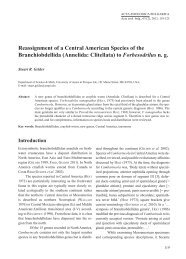
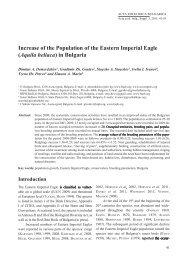
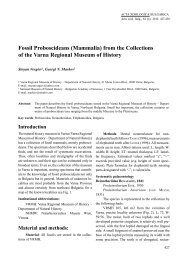
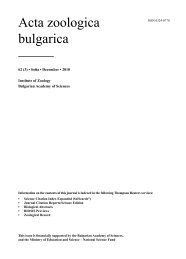
![table of contents [PDF] - Acta zoologica bulgarica](https://img.yumpu.com/52655254/1/186x260/table-of-contents-pdf-acta-zoologica-bulgarica.jpg?quality=85)
![table of contents [PDF] - Acta zoologica bulgarica](https://img.yumpu.com/52655255/1/186x260/table-of-contents-pdf-acta-zoologica-bulgarica.jpg?quality=85)
